 Nov 29 2021
Nov 29 2021Notes From the Field: Powell River Trip
In September 2021, Ancient Forest Alliance visited the city of Powell River to explore the region’s remaining old-growth forests, and meet with local community members and the Tla’amin First Nation to hear their views on the conservation of old-growth forests in the region. We experienced awe-inspiring landscapes, stunning ancient rainforests, and fascinating perspectives on old-growth conservation.
The area around Powell River has been stewarded since time immemorial by the Tla’amin and shíshálh First Nations. Since its founding, the town of Powell River has been deeply defined by the forest industry. Its valleys of monumental forests were easily accessible, and industrial logging has been ongoing in the region since the 19th century. Long dominated by its huge pulp mill, Powell River is a growing destination for ecotourism.
I (Ian Thomas) and TJ Watt were invited by the local qathet Old-Growth group to highlight some of the remaining old-growth forests in the Powell River region. We were joined by filmmaker Robin Munshaw to film a second community spotlight video about old-growth conservation in this magnificent area. We were generously hosted by local advocate Rachel Sherstad, who invited us to stay at her beautiful organic farm just outside the city of Powell River.
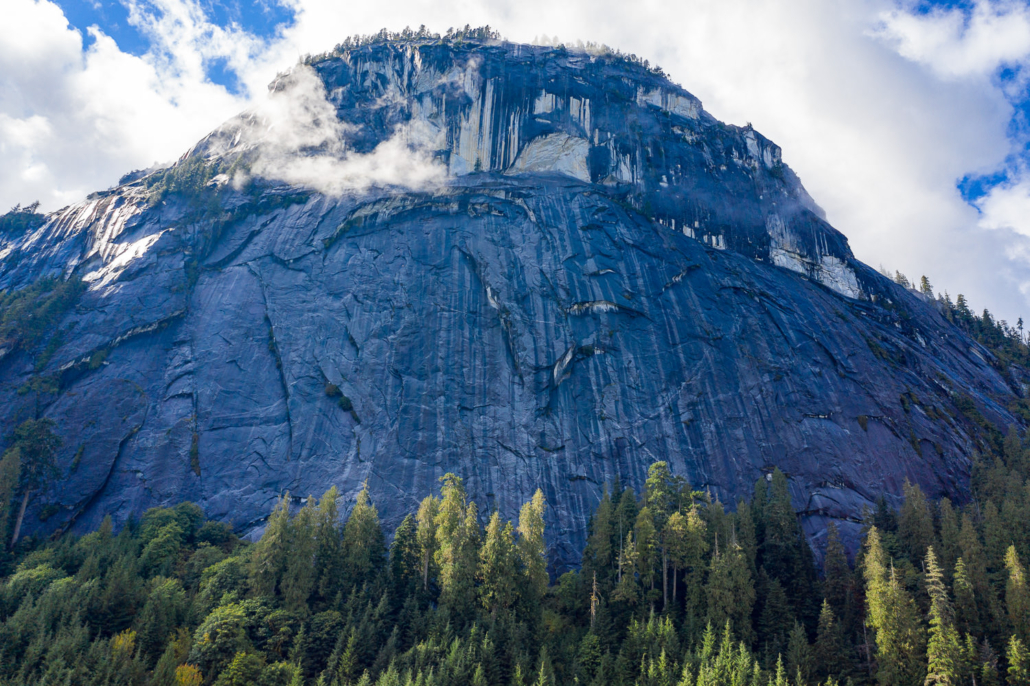
Massive granite walls, popular with local rock climbers, tower thousands of feet into the air in the Eldred Valley.
The towering granite walls of the Eldred River Valley.
Mt. Freda
On the first day, we went up Mt. Freda with Erik Blaney. Erik is a member of the Tla’amin First Nation and has been a strong voice for old-growth conservation in his territory. Recently, the Tla’amin requested that Western Forest Products pause all old-growth logging in their territory. One of their paused cutblocks on Mt. Freda is 21 hectares (52 acres) in size and is located at over 1,100 metres (3,609 feet) above sea level. The steep, winding road that snaked up the mountain to this paused cutblock was a powerful reminder of the extreme lengths that logging companies are going to in order to carve out the last vestiges of old-growth forest from the landscape. Stands of sub-alpine rainforests like these represent the most ancient forests known in Canada. Members of the qathet Old-Growth group found that some of the trees logged on Mt. Freda were over 1,200 years old. If these trees were artifacts or buildings, they would be treasured in museums or protected by law; but in 21st century Canada, it’s completely legal to blast a road through sensitive mountain wetlands, cut down a tree well into its second millennium, and leave behind a stump field where an ancient forest once stood. It is hard to find the words to capture the antiquity of these forests when the trees themselves are older than the English language as we know it.
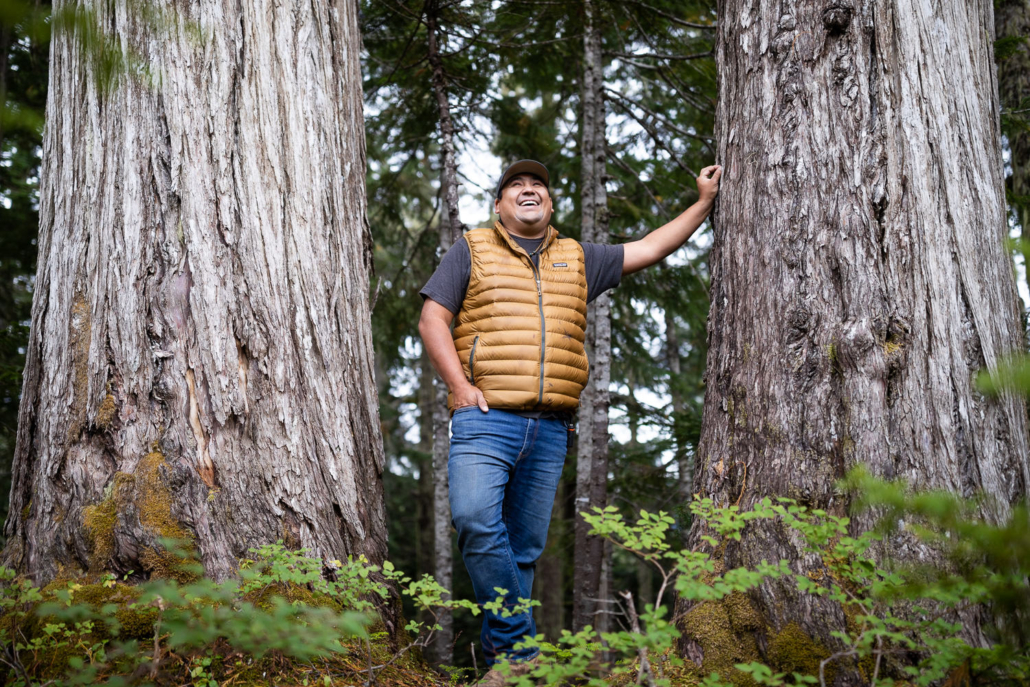
Erik Blaney of the Tla’amin First Nation between two ancient yellow cedars on Mt. Freda.

During our interview with Erik, we learned that, twenty years ago, when the Tla’amin nation was seeking a tree from which to carve a traditional ocean-going canoe, they searched their vast territory and could only find six suitable trees. Out of the thousands of usable old-growth trees that would have been present a century ago, only six remained.
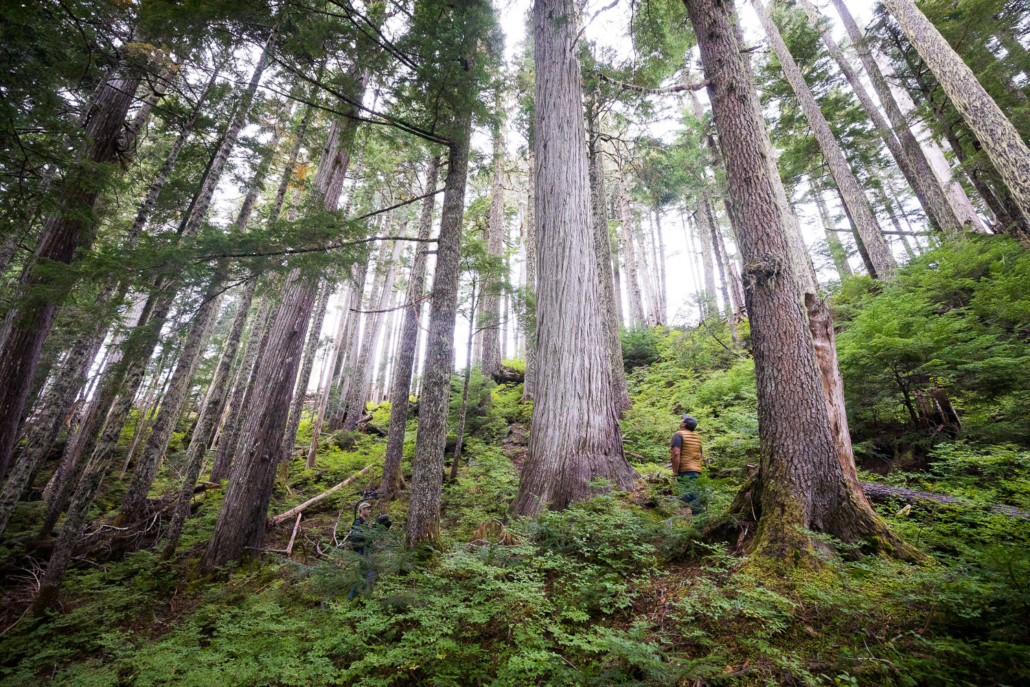
A giant old-growth yellow cedar within an approved cutblock, now temporarily deferred
After interviewing Erik, we explored the still-standing portion of the approved cutblock. We found giant yellow cedars, likely over a thousand years old, towering over slopes that glowed with blue-green blueberry shrubs. The soft forest floor was braided by little creeks meandering through mossy beds, filling the woods with constant music of falling water. Few forests anywhere have such a sense of timeless peace as these primeval sub-alpine groves. Nearby, picturesque alpine tarns were glowing with soft reds and golds as Autumn began its slow creep down the mountainside. High in the mountains and locked in by snow for much of the year, these forests are incredibly slow-growing, delicate ecosystems. For this reason, it’s more accurate to call the clearcutting of them a form of “tree-mining” rather than forestry, as it will be many generations before such forests ever recover from the destructive clearcutting that is BC’s standard forestry practice.
It’s sobering to think that without the leadership and initiative of Erik Blaney and the Tla’amin First Nation, this timeless forest we were exploring would’ve been completely erased. Without any action by the provincial government to help transition communities away from old-growth logging, this site could still be logged. Erik explained the economic challenges that the Tla’amin nation faces in protecting their remnant stands of valuable, ancient trees. Erik emphasized that he believes vast tribal parks are necessary to protect Tla’amin culture and that the province of British Columbia needs to provide significant funds to realize that goal.
Eldred Valley
The next day we headed to the Eldred Valley. This majestic valley is revered among rock climbers across Canada for its magnificent battlements of towering granite. We were joined in our exploration by Dr. Andrew Bryant, an ecologist with a lifetime of experience researching wildlife in coastal British Columbia. The lion’s share of Andrew’s work has been in saving the endangered Vancouver Island marmot from extinction. He has also done research on the old-growth-dependent marbled murrelet and led pioneering work on how forest-dwelling birds respond to different methods of logging. His decades of experience studying coastal ecology provided a fascinating perspective on the ecological importance of old-growth forests.
On our way into the Eldred, we stopped at Goat Mountain. Andrew told us that in the fall, the local natural history club comes to this spot to watch mountain goats foraging on the sheer cliffs. Though iconically associated with the treeless expanses of ice and rock that dominate the forbidding peaks of British Columbia’s mountains, this monarch of the alpine realm is actually dependent on the rainforest for its survival. The Coast Mountains experience extreme winter snowfall, and mountain goats here must retreat to forested winter ranges to access the forage that will keep them alive through the winter. The BC government’s own conservation plan for mountain goats identifies the loss of old-growth forests as a key threat to their survival. The mountain goat then is a crucial reminder of the way in which old-growth forests sustain a huge variety of creatures that seem only tenuously connected to them: from coho salmon deep in the Pacific Ocean to a mountain goat perched high on a granite slab

default
As we entered the Eldred and saw on all sides its soaring granite walls, we immediately understood the reason for its legendary status in the climbing community. There was an indescribable majesty in watching the clouds drift through the valley; the peaks looked like huge islands washed by foaming surf, and we were mesmerized by the always-shifting pageantry of cloud and stone, broken by sudden windows of dazzling sunlight. Contrasting with the primeval wildness of these monumental stone faces was the heavily exploited forest of the valley. It was like the entire valley floor had been gouged with an enormous ice cream scoop, with the only remaining old-growth forests hanging on in tenacious little slivers of dark green on the very fringes of sheer rock. Despite driving for over three hours up the Eldred on rough logging roads, we still couldn’t reach any accessible old-growth to showcase in our interview with Andrew. Eventually, we settled in front of the castle-like stump of what had once been an ancient redcedar and listened to Andrew explain the critical ecological importance of ancient forests.
After interviewing Andrew, we were determined to see any scrap of remaining old-growth that we could, so we set out in search of the shreds of old-growth still clinging to the upper walls of the Eldred. We hiked up through a gloomy second-growth forest where the closed canopy of young trees blocks out the necessary light for understory dwelling shrubs and forbs. Such barren forests are deserts to foraging deer and for the wolves and cougars that depend on them. We had driven three hours deep into the Eldred and, though we hiked further and further up, we still couldn’t find a single old-growth tree. As we climbed higher, the ground fell away on all sides until we were walking a narrow ridge, only wide enough for us to continue in single file. This slender bridge led directly into a remnant stand of ancient forest

Conservation Biologist Andrew Bryant beside a massive cedar stump amongst second-growth in the Eldred Valley.
Dr. Andrew Bryant beside a giant cedar stump in second-growth.

Unprotected monumental redcedars can still be found at the base of of some of the climbing walls in the valley.
The moment we set foot in the old-growth grove, we passed through a threshold into another world. After the dark, lifeless gloom of the logged-over second-growth, suddenly there was light and green and life. We’ve had the privilege to explore many ancient groves in BC, and still, we were stunned by the beauty we’d stumbled into. The glade was split by a stream of clear water overhung with devil’s club, blueberry, and sword fern. The forest floor was a gently sloping garden of oak fern and queen’s cup. Rising above it all, were the magnificent trunks of enormous redcedars; ancient monarchs still ruling this quiet glade as they had for centuries. As we wandered through this garden of giants, we found the daybeds of animals nestled among the roots of the colossal cedars, and on their bark, the claw marks of bears. This grove was clearly a precious oasis for the wildlife of the region. We could easily imagine them creeping up, just like we had, through the vast wasteland of second-growth forest, so they could rest or feed in this far-flung refuge, nestled against the granite teeth of the Eldred.
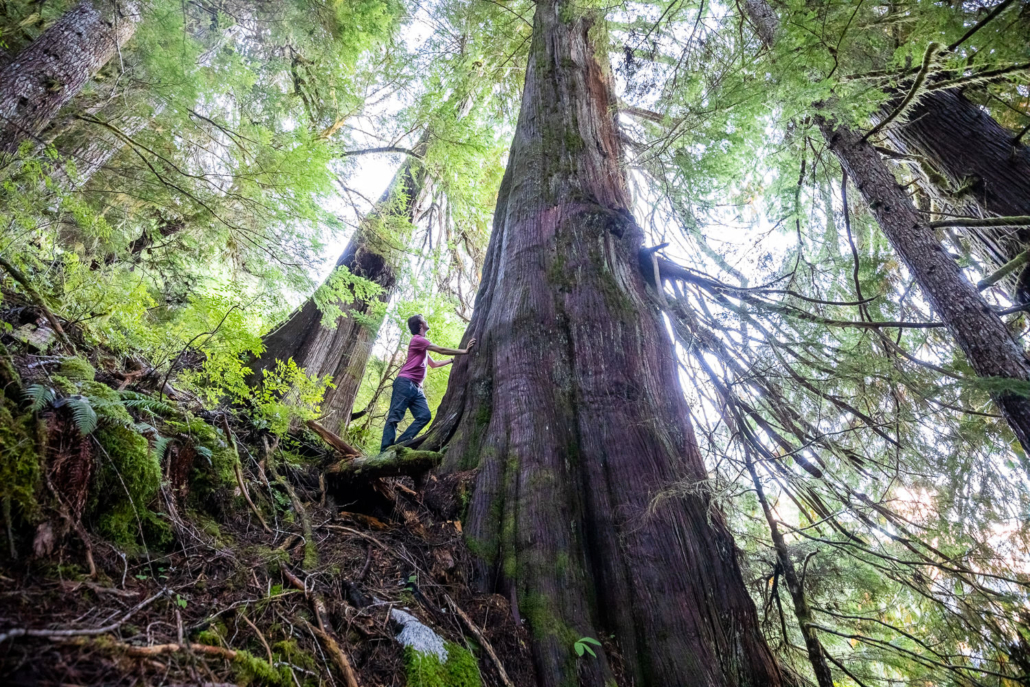

From this vantage point, we could see the popular climbing wall of Amon Rudh and its dark green beard of remaining old-growth. Amon Rudh is named after a mountain in J.R.R. Tolkien’s world of Middle Earth. In Tolkien’s legendarium, this mountain is the refuge of the doomed hero Turin, who takes shelter there from the conquering forces of Tolkien’s primeval dark lord. Tolkien was a pioneer in the way he linked the traditional struggles of good and evil – expected from fantasy – with vivid imagery of ecological devastation. It’s not lost on anyone who knows the story of Amon Rudh, a symbol of heroic resistance to the forces of destruction, that the Eldred’s Amon Rudh holds some of the last remnants of healthy forest in a valley nearly conquered by clearcut logging. In recent years, the local climbing community of Powell River has been actively opposing plans to clearcut this last, tiny trace of the Eldred’s ancient rainforests.

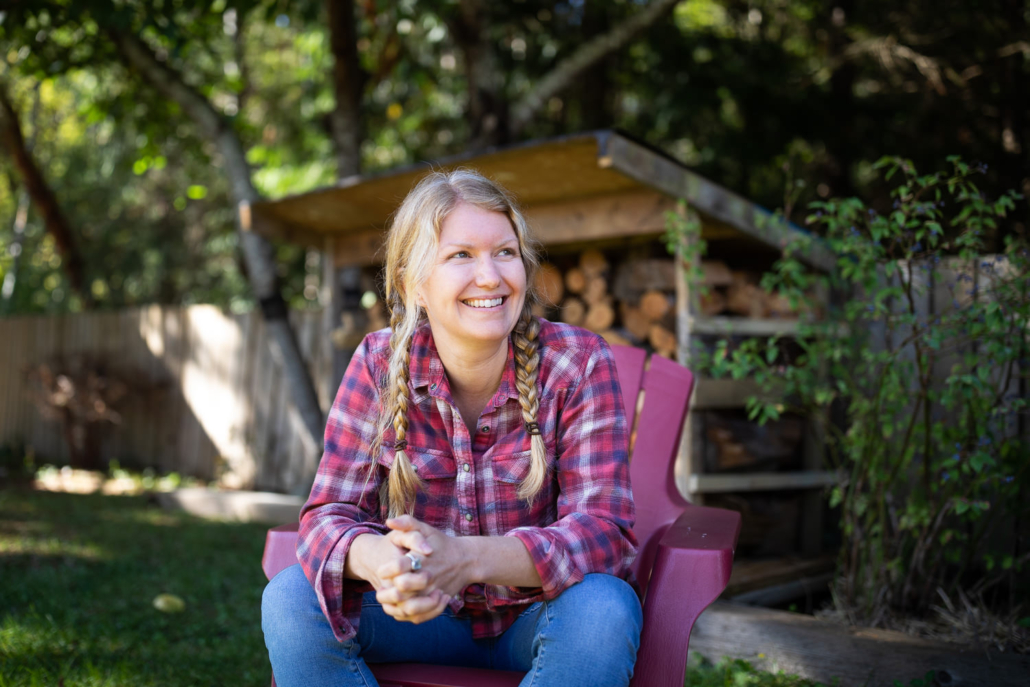
Local advocate and qathet Old-Growth member, Jill Marie Bronson.
On our third day, we interviewed Jill Marie Bronson, one of the founders of the qathet Old-Growth group. She’s been doing fantastic work documenting and advocating for old-growth forests in the Powell River region. Jill Marie defies the stereotype of your average old-growth forest advocate. Deeply connected to BC’s logging industry, Jill Marie’s father works as a tree-faller and she herself has worked in laying out cutblocks. Educated in forestry, Jill Marie provided a fascinating and insightful perspective on the old-growth forest issues in the region.
That afternoon, we headed out of Powell River, reflecting on our fascinating three-day adventure. We interviewed people with diverse perspectives on biology, forestry, economics, and First Nations culture. Yet, despite these varied backgrounds, the consensus was clear: things need to change. The Powell River region is a perfect microcosm of the issues facing First Nations and forestry communities across British Columbia. How can they transition away from old-growth logging? Despite a history deeply steeped in forestry, community members from all different backgrounds are increasingly sounding the alarm on the destruction and unsustainable future of old-growth logging. They’re asking for leadership and financial support from a provincial government that still seems unwilling to act.



